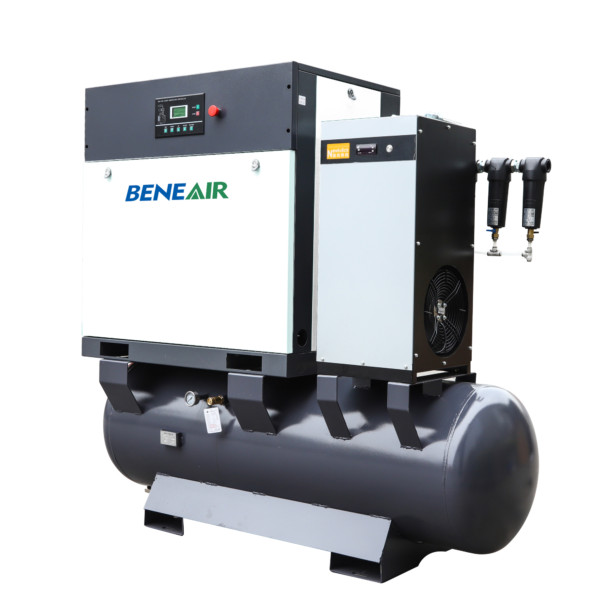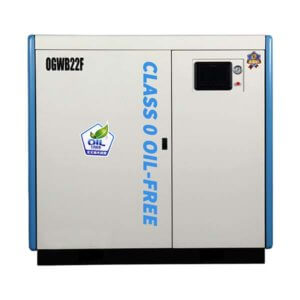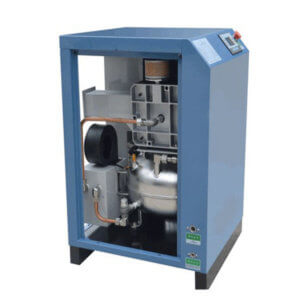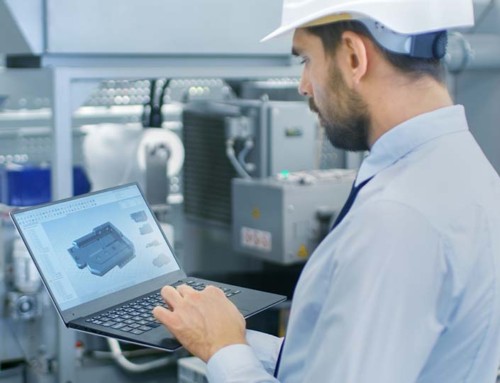Contents
A Variable Speed Rotary Screw Air Compressor is a type of compressor that uses a motor to drive the rotary screw. It is often built for continuous running, or it can run periodically, like during start-up. The rotary screw compressor is generally more efficient than the reciprocating air compressor (scroll compressor).
Variable-speed air compressor Components
Variable-speed air compressor Components
The compressor has several parts that are important to its operation. The electric motor, the rotary screw, the inlet and outlet valves, the pressure relief valve, and the oil separator work together to create a continuous compressed air supply.
The electric motor:
The electric motor is what powers the compressor. It is often a three-phase AC induction motor but can also be a permanent magnet or DC. The rotary screw compressor uses an electric motor to turn the rotary screw inside the shell. Different types of engines are used depending on the size of the unit. Small units may have a ½ to 2 hp single phase induction motor, while larger units use higher horsepower motors.
The rotary screw:
The rotary screw is what compresses the air. It is a helical screw that is turned by the electric motor. The rotary screw moves the air through the compressor and squeezes it as it goes.
The inlet and outlet valves:
The inlet and outlet valves control airflow into and out of the compressor. They are two-way valves that are opened to allow the flow of compressed air to be taken from the unit or pressurized air to go into it.
The pressure relief valve:
Overpressurizing the motor can be prevented with the pressure relief valve. It senses when the correct pressure is reached in the compressor and opens to release the tension. This prevents the engine from being damaged by over-pressurizing.
The oil separator:
The oil separator is a vital part of the compressor. Through it, compressed air is separated from the oil. The oil is then collected in a container and drained off periodically. If the oil is not separated from the compressed air, it can build up and cause damage to the compressor.

Working Principle
Working Principle
The variable speed rotary screw compressor uses a motor to drive the rotary screw. The rotary screw compresses the air and pushes it through the inlet and outlet valves. The pressure relief valve senses when the correct amount of pressure is reached in the compressor and opens to release the tension.
In this way, over-pressurizing will not damage the motor. Oil is collected from compressed air by an oil separator and is drained periodically. Rotary screw compressors are generally more efficient than reciprocating compressors but cannot provide a high-pressure ratio or run quietly.
Application of a variable-speed air compressor
Application of a variable-speed air compressor
A variety of applications are served by these types of compressors. They are often found on.
Pneumatic tools:
Variable-speed rotary screw compressors are often used in pneumatic tools. Because it is easier to modify or replace the rotary screw than a piston compressor, it found its way into many different small tools.
Blowers:
Variable-speed air compressors can be used in blower applications that use medium volume and pressure. They are perfect for continuous running applications.
Airlocks:
These compressors are also used in airlock applications. This type of compressor can handle the high cycling rates standard in airlocks.
Tank pressure regulation:
Rotary screw compressors can also be used to regulate tank pressure. After reaching a certain point in the tank pressure, the compressor cycles on to lower the pressure.
Dust collection systems:
Variable-speed rotary screw compressors are also used in dust collection systems. They can handle the high cycling rates that are common in dust collectors.
Paint booths:
Rotary screw compressors with variable speed are also used in paint booth applications. They can handle the high cycle rates that are common in paint booths.
Medical devices:
Rotary screw compressors are also used in medical devices. They can handle the high cycling rates that are common in medical devices.
Fixed VS Variable Speed Air Compressors
Fixed VS Variable Speed Air Compressors
The fixed-speed air compressor is the traditional method for producing compressed air. A motor runs at a single speed, and matching fans are used to deliver the required airflow volume.
The advantage of these systems is high efficiency over an extensive range of flow rates. These compressors are easy to specify since they require no unique controls or maintenance considerations beyond the motor’s ones.
The downside of fixed-speed compressors is that they can be less than ideal for some applications. In cases where the airflow requirements vary a great deal, or when there is a need for deficient noise levels, then a variable-speed compressor might be a better option.
A variable air compressor alters the motor speed to match varying air volume requirements. Variable-speed air compressors can be designed several ways, but most systems use either a VSD (variable-speed drive) or an inverter.
When using a VSD, the compressor’s motor is fed from the variable output of an external source such as a variable frequency drive (VFD). This type of system effectively matches the airflow requirements over a wide range of speeds.
DC to AC power conversion devices are called inverters. When used in an air compressor system, they provide the ability to vary the speed of the motor by controlling the frequency of the input power. Inverters operate over an extensive speed range and can provide precise control.
Variable speed compressors’ main advantages
Variable speed compressors’ main advantages
- They do not require any complex controls system, just a simple on/off switch. Installation and maintenance costs can be reduced accordingly. Additionally, since they only need to be adjusted for airflow, they are very easy to use.
- Applications requiring precision pressure, volume, or frequency control are ideal for using them.
- Variable-speed compressors can produce deficient noise levels because their speed can be reduced to match the exact airflow requirements.
- They also provide significant energy savings over time since they only run when needed.
Limitations of variable speed compressors are:
- The cost of purchasing and installing them can be higher.
- They require more sophisticated controls than fixed-speed compressors.
- They can be noisier than fixed-speed systems.
In short, Variable speed air compressors are becoming more and more popular in various applications. They are ideal for many different applications due to their ability to adapt to airflow requirements. They also offer significant energy savings over time, making them a wise investment for any facility.









Leave A Comment